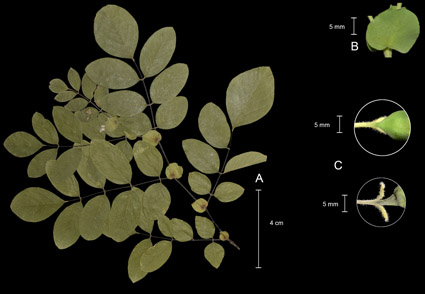Abstract
A new species of Brongniartia is described from southwestern Oaxaca in México, where it occurs in Seasonally Dry Tropical Forests and Woodlands. Brongniartia dulce is discussed in relation to other members of the genus and their morphological characters, particularly the shape and size of the stipules and bracteoles.
References
- Britton, N.L. & Rose, J.N. (1928) Mimosaceae (continuatio). North American Flora 23 (2): 86.
- Comisión Nacional del Agua (CNA) (1998) Cuencas Hidrológicas. Escala 1:250000. México.
- Cardoso, D., Harris, D., Wieringa, J., So-Mateus, W., Batalha-Filho, Torke, H., B., Prenner, G. & de Queiroz, L.P. (2017) A molecular-dated phylogeny and biogeography of the monotypic legume genus Haplormosia, a missing African branch of the otherwise American-Australian Brongniartieae clade. Molecular Phylogenetics and Evolution 107: 431–442.
- Dorado, O. (1988) A. morphological revision of the Podalyrioides group of Brongniartia (Fabaceae: Faboideae). Master of Science Thesis. Claremont Graduate School, Claremont, California. 158 pp.
- Dorado, O., Arias, D.M. & de Jesús-Almonte, J.M. (2019) Brongniartia bicornuta (Leguminosae, Papilionoideae), a New Species from the Seasonally Dry Tropical Forests of the Balsas River Basin, México. Systematic Botany 44 (1): 139–145.
- DRYFLOR. (2016) Plant diversity patterns in neotropical dry forests and their conservation implications. Science 353: 1383–1387.
- Front Quer, P. (2000) Diccionario de botánica, Edición Ilustrada. Peninsula, Barcelona, España. 1244 pp.
- Jacquin, N.J. (1760) Enumeratio sistemática plantarumquas in insulis Caribaeis vicinaque Americes continente detexit nouas, aut iam cognitas emandauit. Apud Theodorum Haak, Lugduni Batavorum [Leiden] (Holanda), 41 pp.
- Jiménez-Ramírez, J., Vega, J.K. & Cruz, R. (2009) Brongniaria balsensis (Leguminosae, Papilionoideae), una especie nueva de la depresión del Río Balsas, México. Novon 9: 360–363.
- Harms, H. (1908) Leguminosae andinae. Botanische Jahrbücher für Systematik, Pflanzengeschichte und Pflanzengeographie 42 (1): 88–97.
- Hemsley, W.B. (1879) Botany. Biologia Centrali-Americana 1 (3): 254–255.
- INEGI (2016) Áreas geoestadísticas municipales, 2015, escala: 1:250000. edición: 2015. Instituto Nacional de Estadística y Geografía. Aguascalientes, México.
- INEGI (2018) Áreas Geoestadísticas estatales 1:250000. 2018, escala: 1:250000. edición: 1. Instituto Nacional de Estadística y Geografía. Aguascalientes, México.
- IPNI (2023) International Plant Names Index. The Royal Botanic Gardens, Kew, Harvard University Herbaria & Libraries and Australian National Botanic Gardens. Available from: http://www.ipni.org/ (accessed 15 October 2023)
- IUCN (2012) Red List Categories and Criteria of IUCN. Version 3.1. Second edition. Gland, Switzerland and Cambridge, UK: IUCN. iv + 32 pp. (accessed 10 August 2023)
- Kadereit, G., Mucina, L. & Freitag, H. (2006) Phylogeny of Salicornioideae (Chenopodiaceae): diversification, biogeography, and evolutionary trends in leaf and flower morphology. Taxon (55) 3: 617–642.
- Kunth, C.S. (1823) Leguminosae. Nova Genera et Species Plantarum (quarto ed.) 6: 465–469.
- Linnaeus, C.V. (1753) Species Plantarum 1. Holmiae, 560 pp.
- Linnaeus, C.V. (1759) Diadelphya. In: Systema Naturae, Editio Decima 2. pp. 769.
- Micheli, M. (1903) Légumineuses récoltées dans les états Mexicains de Michoacan et de Guerrero. Mémoires de la Société de Physique et d’Histoire Naturelle de Genève 34: 243–250.
- Moreno, N. (1984) Glosario botánico ilustrado. Editorial Continental, Distrito Federal, México. 300 pp.
- Moricand, M.É. (1836) Memoires de la Société de physique et d’histoire naturelle de Genève 7: 253.
- Nixon, K. & Wheeler, Q.D. (1990) An amplification of the phylogenetic species concept. Cladistics 6: 211–223. https://doi.org/10.1111/j.1096-0031.1990.tb00541.x
- POWO (2021) Plants of the World Online. Facilitated by the Royal Botanic Gardens, Kew. Available from: https://powo.science.kew.org/ (accessed 8 September 2021)
- Queiroz, L.P. de., Sao-Mateus, W., Delgado-Salinas, A., Torke, B., Lewis, G., Dorado, O., Ardley, J., Wojciechowski, M. & Cardoso, D. (2017) A molecular phylogeny reveals the Cuban enigmatic genus Behaimia as a new piece in the Brongniartieae puzzle of papilionoid legumes. Molecular Phylogenetics and Evolution 109: 191–202.
- Rafinesque, C.S. (1838) Trees and shrubs of north America and other parts. Sylva Telluriana 118.
- Rose, J.N. (1899) Studies of Mexican and Central American. Systematic, Economic, and Ecological investigations, Contributions from the United States National Herbarium 5 (4): 145–260.
- Rose, J.N. (1909) Mexican and central american plants. Contributions from the United States National Herbarium 12 (7): 269–302.
- Sharma, V. & Kumar, S. (2013) Parallelismic homoplasy of leaf and stipule phenotypes among genetic variants of Pisum sativum and Medicago truncatula and some taxa of Papilionoideae, Caesalpinioideae and Mimosoideae subfamilies of the Leguminosae flora of Delhi. Plant Systematics and Evolution 299: 887–911.
- Taubert, P. (1895) Plantae Selerianae. Bulletin de l’Herbier Boissier, Suisse (Suiza) 3: 609–672.
- Walpers, G.G. (1842) Repertorium Botanices Systematicae, vol. 1 (4). Sumtibus Friderici Hofmeister, Lipsiae, (Alemania), 947 pp.
- Watson, S. (1885) Contributions to American Botany. Proceedings of the American Academy of Arts and Sciences 20: 324–378.


